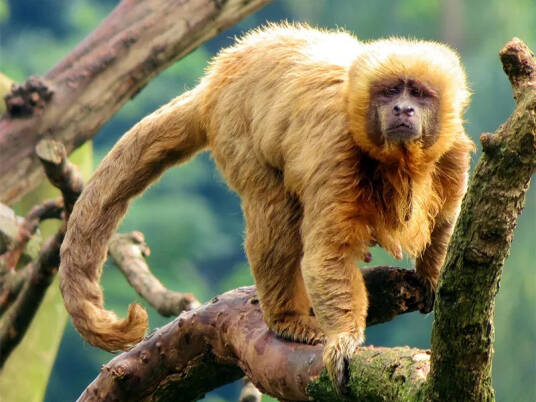Sapajus flavius
IUCN
LCBasic Information
Scientific classification
- name:Sapajus flavius
- Scientific Name:Sapajus flavius, Blonde Capuchin、 Marcgrave's Capuchin Monkey, Blonder Kapuzineraffe
- Outline:Primates
- Family:C.m.family
Vital signs
- length:35-40cm
- Weight:2-3kg
- lifetime:40-50years
Feature
The body hair is almost uniformly golden yellow
Distribution and Habitat
The golden monkey is found in the Atlantic Forest of northeastern Brazil, in the states of Alagoas, Pernambuco, Paraíba and Rio Grande do Norte.
The golden monkey inhabits Atlantic Forest woodlands in northeastern Brazil, mostly surrounded by sugarcane plantations. These woodlands are secondary, semi-deciduous seasonal forests with a canopy height of about 20 meters and new growth of about 25 meters. The understory vegetation consists of shrubs and vines, which is typical of disturbed forests.
Appearance
The head and body length of the golden monkey is 35-40 cm, similar to other monkey species. The length of the tail is almost equal to the length of the head and body, also 35-40 cm, and the weight is 2-3 kg. The body hair is almost uniformly golden yellow, the top of their head is white, the cheeks have well-developed masseter muscles, giving the impression of swelling, pink, with some dark spots. The hands and legs are black. The iris is light brown, and there is a dark hairless throat flap on the ventral side of the neck. The hair on the feet and hands is much lighter than the rest of the coat, while the palms and soles of the feet are hairless and black. The hair on the head grows backwards without tufts.
Details
Blonde Capuchin (scientific name: Sapajus flavius) English Blonde Capuchin, Marcgrave's Capuchin Monkey, German Blonder Kapuzineraffe, no subspecies, is a smaller species of Sapajus species.

In 1648, German naturalist Georg Marcgrave first described the golden monkey as "caitaia". In 1774, Johann Christian Daniel von Schreber postulated Simia flavia as a separate species, but it long lacked any specimens. It was not until 2006 that researchers divided and named it a new species. In 2011, Jessica Lynch Alfaro et al. suggested placing Simia flavia (formerly known as the C. apella group) in a separate genus "Sapajus" along with the capuchins (formerly known as the C. capucinus group) that retain the Cebus genus.
Little is known about the lifestyle of the Simia flavia. Like all monkeys, they are a diurnal, arboreal animal. They live in groups of 18 animals, consisting of several males and females and their common offspring. The family range of the golden monkey ranges from 80-187 hectares, and the minimum population can reach 70 individuals.
The golden monkey is mainly a frugivorous insectivorous animal. In some areas, oil palm (Elaeis spp.) and sugar cane are the main food resources. The golden monkey has the largest population of all monkey species and reproduces very successfully. They are highly adaptable to fragmented and human-modified habitats, which is why they can persist in the remnant forests of the Atlantic Forest in northeastern Brazil.
The golden monkey has a polygamous mating system, with an interval of 19-24 months between births, a gestation period of 5-6 months, and one baby per litter. In 2014, a female was observed with two babies, but it cannot be confirmed that they were twins. The life span of the golden monkey in captivity can reach 40-50 years. Genetic characteristics, karyotype: 2n=54, NF=73.
The golden-haired monkey is endemic to the northeastern Atlantic Forest, occurring only in fragmented forest plots in a few areas of the states of RN, PB, PE and AL. Its range of occurrence is about 23,000 km2, but its area of occupancy is small, close to 150 km2. Historically, the species has suffered a habitat loss of at least 50%, which has led to an equal population decline, aggravated by hunting and severe habitat fragmentation. Factors such as deforestation, agriculture, urban expansion and logging have reduced the total species population to around 1,000 individuals. Therefore, the species is listed as Endangered (EN) according to the A2cd + B2ab(ii,iii) + C2a(i) criteria.
Listed in the IUCN Red List of Threatened Species in 2020 ver3.1 - Endangered (EN).
Listed in Appendix I, II and III of the Convention on International Trade in Endangered Species of Wild Fauna and Flora (CITES) 2019 edition Appendix II.
Protect wild animals and eliminate game.
Maintaining ecological balance is everyone's responsibility!








